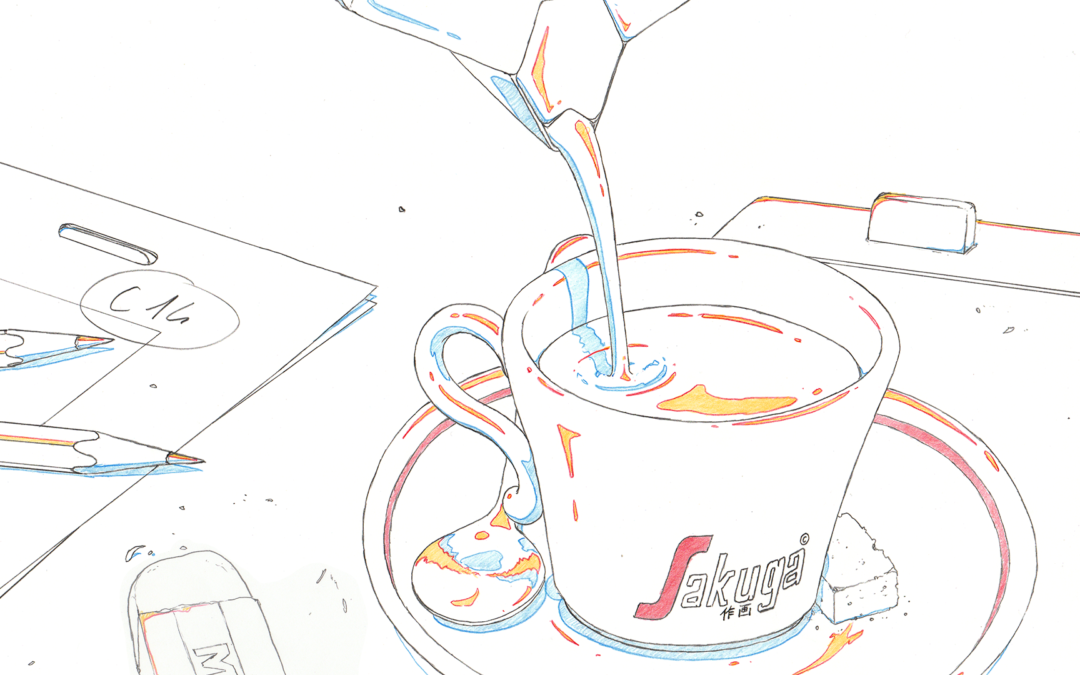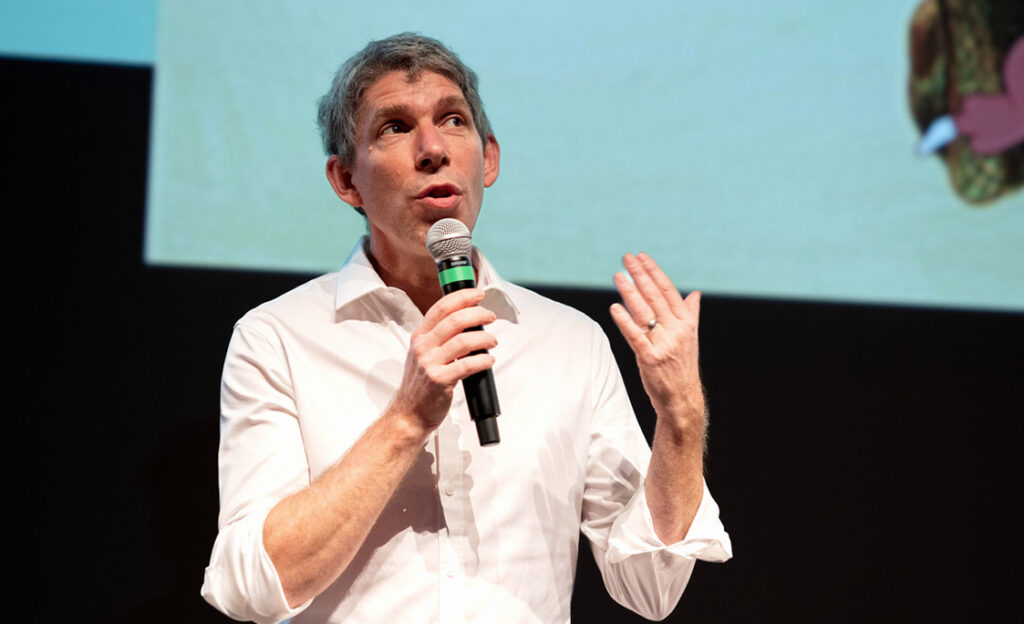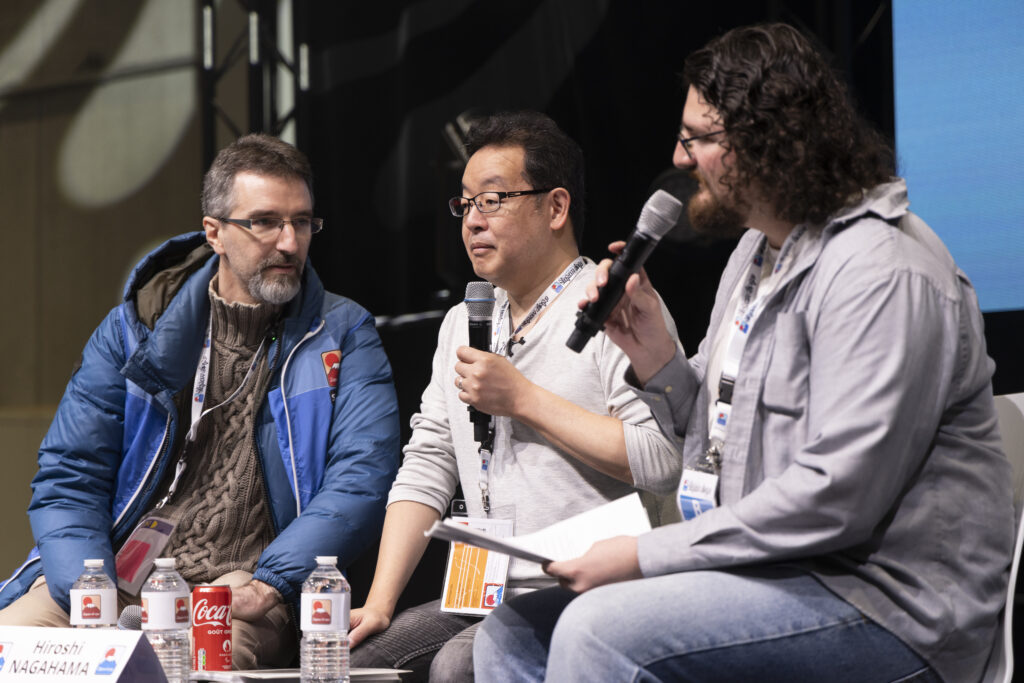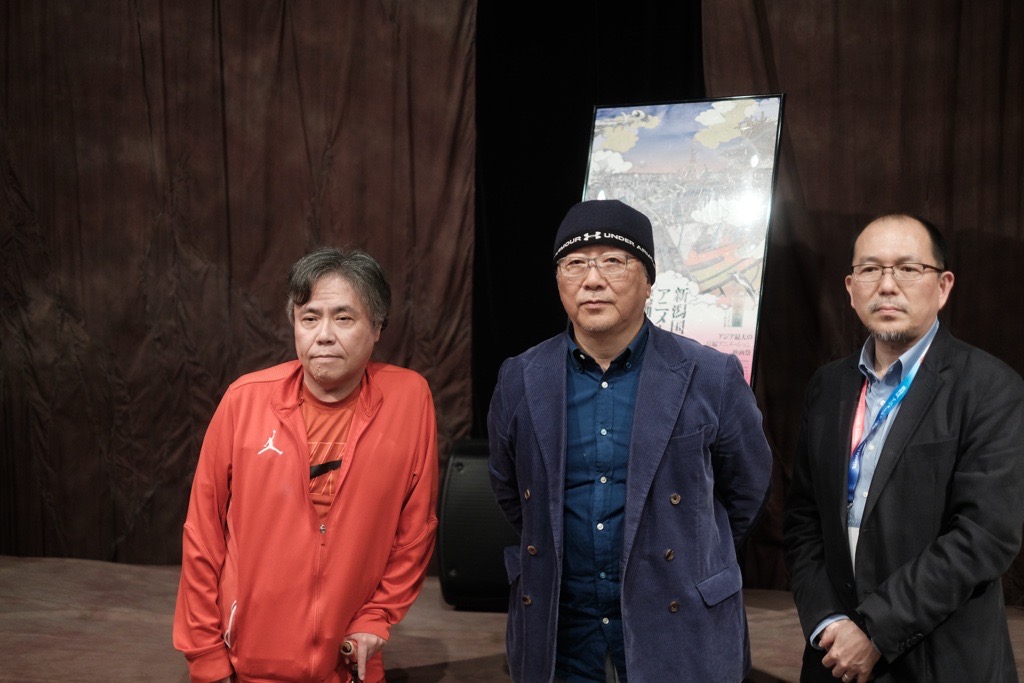Sakuga Espresso is our column about appreciating great animation in a format short enough to be read along with a shot of Espresso. ☕️
What makes a scene stand out? How do the drawings convey emotions?
Join us as we breakdown what makes stunning animation.
Illustration by Guillaume Carobbio
Like our content? Feel free to support us on Ko-Fi!
Sakuga Espresso – Digimon
Mitsuo Iso is an animator who perhaps needs no introduction. As soon as you start talking about Sakuga, he is probably one of the first names you think of and to good avail. He is the ambassador of Full Limited Animation, a method consisting of animating scenes only with key animation and no intervals. It is a habit he has taken from the flipbooks he used to draw as a child and through which he has learned to animate. This technique emphasizes movement, weight, and, combined with Iso’s care for detail, is why his style is referred to as “ultra-realism.”
To show examples of Iso’s style, people will commonly show some of the awe-inspiring action cuts he did, for instance, these scenes for The End of Evangelion or Ghost in the Shell.
But today, I would like to show how Iso’s ultra-realism translates when used for character acting.
I love Hosoda’s Digimon movie. It is among the last animes to use celluloids, which, coupled to the use of Kagenashi – the practice of not using any shadows for its characters – gives off a unique, flat aesthetic, putting forward the paint on the celluloids and the color palettes used.
You may notice in the scene that characters are always moving, even if only a little as a result of Full Limited. You feel the weight of Taichi’s body as he is trying to take a breath because of how detailed his shoulder move. The movement feels genuine and likely because each tiny movement and expression is exaggerated by the quantity of strong, key poses. You may particularly feel it when Hikari is out of breath and starts coughing and snorting; this shot feels more real than real because of the timing and detail of each frame and movement.
As such, it is to my eye a prime example of ultra-realism where exaggerated movement is perceived as likely, more-so even than real movements.
When watching Iso’s acting for Digimon, I can’t help but think of a previous scene he did: his cut for the climax of 1995’s movie Junkers, come here. When I talked about this scene with Iso, he exclaimed how hard it was to animate because of the number of drawings he had to produce.
You can notice how similar they feel—constant, subtle, but exaggerated movement highlighting the characters’ emotions and feelings. I like the accent that is put on the shoulders alongside each breath but also the detailed facial expressions. The editing is very well-timed as each shot – counter shot allows us to absorb the emotions spilled out by the scene.
I think these two scenes do a great job of demonstrating how the use of Full Limited animation enhances the feelings of the scene through a seemingly realistic use of exaggerated movement. ☕
Sakuga Espresso – Yu Yu Hakusho
It is no question in my mind that animator Atsushi Wakabayashi (nicknamed Kaba-san by peers because that name is a mouthful!) embodies the aesthetic of anime. The way his characters dart in and out with smooth kineticism, from far in the background to right up into your face – it’s a feast for the eye! And as wild and frantic as it may be, it’s easy to follow yet at the same time, never predictable.
In order to achieve such fluid movement, Wakabayashi abandons character modals, leveraging a more rounded and simplified design to depict the subject from multiple angles in a single cut. You start to see this most around the 8 second mark, as the Masked fighter dodges Shishiwakamaru’s attacks, flipping into the distant background only to handspring back into the foreground. And even though the camera moves very little, and the background is relatively flat, there’s a tangible sense of the characters inhabiting a three-dimensional space.
Because of this we are drawn in. Wakabayashi transports us into the ring instead of merely viewing the spectacle from the sidelines. That’s powerful. Like being able to watch a basketball game while standing in the middle of the court. Characters have a perceptible volume instead of being flat images on the screen. This volume translates into weight, making each movement more meaningful to us.
What’s more is that Kaba-san is ever mindful of perspective. When the Masked Fighter flips into the air it is beautifully reminiscent of old Kamen Rider reruns, mimicking the blocking and camera placement. When Shishiwakamaru lands, not only does it feel psychically weighted due to masterful follow through animation, it feels emotionally weighted since it’s right in your face! This use of the foreshortened perspective adds more to the illusion of volume, and grabs you by the sholders and screams, ‘Hey this is a real person!’ even if it isn’t. ☕
It is no question in my mind that animator Atsushi Wakabayashi (nicknamed Kaba-san by peers because that name is a mouthful!) embodies the aesthetic of anime. The way his characters dart in and out with smooth kineticism, from far in the background to right up into your face – it’s a feast for the eye! And as wild and frantic as it may be, it’s easy to follow yet at the same time, never predictable.
In order to achieve such fluid movement, Wakabayashi abandons character modals, leveraging a more rounded and simplified design to depict the subject from multiple angles in a single cut. You start to see this most around the 8 second mark, as the Masked fighter dodges Shishiwakamaru’s attacks, flipping into the distant background only to handspring back into the foreground. And even though the camera moves very little, and the background is relatively flat, there’s a tangible sense of the characters inhabiting a three-dimensional space.
And because of this we are drawn in. Wakabayashi transports us into the ring instead of merely viewing the spectacle from the sidelines. That’s powerful. Like being able to watch a basketball game while standing in the middle of the court. Characters have a perceptible volume instead of being flat images on the screen. This volume translates into weight, making each movement more meaningful to us.
What’s more is that Kaba-san is ever mindful of perspective. When the Masked Fighter flips into the air it is beautifully reminiscent of old Kamen Rider reruns, mimicking the blocking and camera placement. When Shishiwakamaru lands, not only does it feel psychically weighted due to masterful follow through animation, it feels emotionally weighted since it’s right in your face! This use of the foreshortened perspective adds more to the illusion of volume, and grabs you by the shoulders and screams, ‘Hey this is a real person!’ even if it isn’t. ☕
Sakuga Espresso – Ghost in the Shell
You are reading the inaugural of Full Frontal’s news series of daily animation articles, Sakuga Espresso! Our goal is to bring you, dear reader, a dose of anime appreciation timed just right to your morning coffee, allowing you to sip on both an espresso, and the sakuga. Today’s subject is Mamorou Oshii’s 1995 masterpiece, Ghost in the Shell. ☕
This whole cut is to help us relate to Motoko, to make her seem human. It comes as a contrast to the scene before it, where Motoko’s naked, robotic frame floats listlessly, skin being applied like it was an item in a factory. So here, the animation carries a great storytelling significance. After seeing her at her most inhuman, we now see her at her most human.
Our vehicle to peer into the character of Motoko Kusanagi, is through the mundane; waking up the next day and rubbing the sleep from her eyes. It’s a universally shared human experience. But since it is one we all are so familiar with, there’s a high expectation set for the animation to communicate how she wakes up. Subconsciously we will compare and contrast, taking notes on similarities and differences between the character’s routine and ours.
When Motoko first gets up there’s a very real sense of weight. The technique being used here is framerate modulation or the amount of time between each new drawing. When you first wake up you feel heavy, and slow. That’s very realistically depicted in this cut; Motoko’s lumbering entry from the bottom of the frame does well to emulate the feeling of raising out of bed.
Contrast that to when the light pours into the room from the open blinds: see how quickly and evenly that was animated by comparison? That clues us in that the awkward, almost clumsiness that we saw before was purposefully depicted. That it’s the character who is gauche, not the animation.
The remainder of the shot allows us to focus on the cityscape through the newly opened frame. This opens a dialog with the viewer about the definition of identity through one’s social surroundings, the thesis of the film. To promote this invisible discussion between the viewer and art, Motoko is reduced to a silhouette. However, there is a special care in the animation to detail her humanity. She stands up, and her arm awkwardly swings at her side as she runs her fingers through her hair. She opens a door to grab her jacket, and we see her shadow on the floor.
But my favorite part is not until the very end of the clip. Against the light, we see Motoko don her jacket, and walk towards us, but just off frame, ending the scene. But as she puts on her jacket, we see a remarkable understanding and control of weight, texture, and how these materials move through space, not just in a 2 dimensional, but a three dimensional space.
Putting on a jacket is also a commonly shared human experience. It’s simple. Because the animation is so simplistic (remember, it’s still just a silhouette) yet detailed, I know (or have a pretty good idea) what that jacket feels like.
The way one sleeve hangs, the way it dangles, betrays it’s weight. The way we can still see the solid object of Motoko’s arm move through the flow of the fabric illustrates the lack of stiffness of the texture. And all of this is happening as she moves towards us, making that world feel real and immersive. Animation, at it’s most human!
This whole cut is to help us relate to Motoko, to make her seem human. It comes as a contrast to the scene before it, where Motoko’s naked, robotic frame floats listlessly, skin being applied like it was an item in a factory. So here, the animation carries a great storytelling significance. After seeing her at her most inhuman, we now see her at her most human.
Our vehicle to peer into the character of Motoko Kusanagi is through the mundane; waking up the next day and rubbing the sleep from her eyes. It’s a universally shared human experience. But since it is one we all are so familiar with, there’s a high expectation set for the animation to communicate how she wakes up. Subconsciously we will compare and contrast, taking notes on similarities and differences between the character’s routine and ours.
When Motoko first gets up, there’s a very real sense of weight. The technique being used here is framerate modulation or the amount of time between each new drawing. When you first wake up you feel heavy, and slow. That’s very realistically depicted in this cut; Motoko’s lumbering entry from the bottom of the frame does well to emulate the feeling of raising out of bed.
Contrast that to when the light pours into the room from the open blinds: see how quickly and evenly that was animated by comparison? That clues us in that the awkward, almost clumsiness that we saw before was purposefully depicted. That it’s the character who is gauche, not the animation.
The remainder of the shot allows us to focus on the cityscape through the newly opened frame. This opens a dialog with the viewer about the definition of identity through one’s social surroundings, the thesis of the film. To promote this invisible discussion between the viewer and art, Motoko is reduced to a silhouette. However, there is a special care in the animation to detail her humanity. She stands up, and her arm awkwardly swings at her side as she runs her fingers through her hair. She opens a door to grab her jacket, and we see her shadow on the floor.
But my favorite part is not until the very end of the clip. Against the light, we see Motoko don her jacket, and walk towards us, but just off frame, ending the scene. But as she puts on her jacket, we see a remarkable understanding and control of weight, texture, and how these materials move through space, not just in a 2 dimensional, but a three dimensional space.
Putting on a jacket is also a commonly shared human experience. It’s simple. Because the animation is so simplistic (remember, it’s still just a silhouette) yet detailed, I know (or have a pretty good idea) what that jacket feels like.
The way one sleeve hangs, the way it dangles, betrays it’s weight. The way we can still see the solid object of Motoko’s arm move through the flow of the fabric illustrates the lack of stiffness of the texture. And all of this is happening as she moves towards us, making that world feel real and immersive. Animation, at it’s most human!
Like our content? Feel free to support us on Ko-Fi!
Benoît Chieux, a career in French animation [Carrefour du Cinéma d’Animation 2023]
Aside from the world-famous Annecy Festival, many smaller animation-related events take place in France over the years. One of the most interesting ones is the Carrefour du Cinéma d’Animation (Crossroads of Animation Film), held in Paris in late November. In 2023,...
Directing Mushishi and other spiraling stories – Hiroshi Nagahama and Uki Satake [Panels at Japan Expo Orléans 2023]
Last October, director Hiroshi Nagahama (Mushishi, The Reflection) and voice actress Uki Satake (QT in Space Dandy) were invited to Japan Expo Orléans, an event of a much smaller scale than the main event they organized in Paris. I was offered to host two of his...
Akira stories – Katsuhiro Otomo and Hiroyuki Kitakubo talk at Niigata International Animation Film Festival 2023
Among the many events taking place during the first Niigata International Animation Film Festival was a Katsuhiro Otomo retrospective, held to celebrate the 45th anniversary of Akira and to accompany the release of Otomo’s Complete Works. All of Otomo’s animated...





I’m really loving these daily espresso essays! From a fellow sakuga fan and an aspiring animator, please keep up the good work!
These shorts really help me to better understand animation in a lexical way, thank you very much for the write-ups!
I love your elaborate and great understanding of animation. These columns are a great read. 🙂